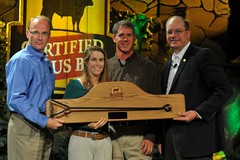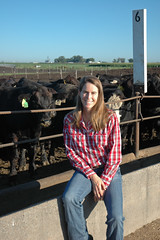Matt’s grandparents moved from Northwestern Ohio to Cozad Nebraska in 1945. Originally, they were Mennonite alfalfa farmers in the Archbold, Ohio area. Converted to the Methodist religion, and desiring to travel west, they loaded their family of four (Grandmother Grace, Grandpa Burky, and sons: Dave and Erv) on the Union Pacific Railroad in 1945 to journey to Nebraska.

Grandmother Grace, Grandpa Burky, Dave and Ann with children Matt and Lara, and Dave’s brother, Erv and his wife Chris and daughter Zoe circa 1976…
The original family farm in Nebraska was a “custom” farm where Matt’s grandpa purchased alfalfa “standing in the field” from neighboring farmers, and then dehydrated the plants into alfalfa dehy pellets. Over the years, Grandpa Burky and Dave (Matt’s dad) were able to purchase some land as well as lease land to farm. The farm continued to shift in this direction as Matt and I came home to work, and today our farm is based primarily on family owned and leased land.
The crop farm expanded to include a cattle feed yard in the late 1960’s. Surrounded by animal feed and successfully established as an alfalfa farmer, Grandpa Burky and his friend, Ray Bates, dreamed of diversifying the farm. Matt’s dad, Dave, had just arrived home from Stanford Business school and was a major contributor to the expansion along with my favorite 79 year old (Archie Curtice).
What began as a few pens now is home to several thousand animals that are fed locally grown crops, and prepared to become the beef that nourishes your family! Archie’s son, Doug, and I now manage the cattle portion of our farm and work hard to carry on the family tradition.

Today, we have the ability to trace our animals from birth to harvest: an important component in my plan to raise the highest quality beef using the fewest natural resources…Here I am weighing an animal to track his gain performance at the feed yard.
It has been 67 years since Matt’s family got on the train and moved west. When I look at what our family has built during that time, I am filled with a tremendous amount of pride. While I have only been lucky enough to spend the last 15 years contributing, I think that what Matt and I do each day is a testimony to what his grandfather began so many years ago.
So what makes up our farm in 2012?
- 1481 acres of organic alfalfa
- 1579 acres of traditional alfalfa
- 617 acres of organic corn
- 966 acres of traditional corn
- 120 acres of traditional soybeans
- 184 acres of traditional wheat
- Approximately 600 acres of cool season grass pasture
- A cattle feed yard that has between 2300-2900 cattle (depending on the time of year)
- 4 horses, 3 dogs, and 7 cats
Much of the traditionally grown corn and alfalfa are fed to our animals in the cattle feed yard. In addition, the wheat stubble and a good portion of the corn stalks (what is left after harvest) is baled to feed to the cattle. We blend these home grown feed ingredients with wet distillers grains to grow our cattle and make beef. We do also purchase some corn from neighbors to augment our personally grown supply. In a twelve month period, our cattle farm will prepare approximately 5500-6000 animals for harvest.

Traced from birth to harvest, I am proud to feed the beef from this animal to both my family and yours…
In 2006, with the increasing availability of wet distillers grains for our cattle and the growing demand for organically grown crops, Matt decided to diversify our crop farm by including organically certified alfalfa and corn. The organic animal feed is sold to organic animal farmers across the country. While this places a limit on the amount of feed that we grow for our own traditionally raised cattle, it opens up a more diverse marketing plan for our farm.
This diversity is a key player in the search for long term sustainability on our farm…I am pretty sure that Grandpa Burky would have never thought that his grandson would raise a blend of crops that included organic feed, or that his granddaughter-in-law would be the Boss Lady at the cattle feed yard. But, the combination of team work and outside sales of a variety of products allows our farm to better weather the challenges that both Mother Nature and the economy bring…













This is why it rubs me the wrong way when people accuse “big” farms of not being sustainable. Having a farm and land in the family for multiple generations is sustainable in my eyes!
I agree with you. My in-laws would be considered a large farm and it has been in the family going on generation 5 (to my best knowledge). It is still family run by my father-in-law, brother-in-law, and my nephew looks to be having a big interest in the farm! The farm has grown to a capacity to keep 2 house holds going instead of just 1, that has to be sustainable!!
To me, the important component of a quality farm is the people that work on the farm–not the size of the farm. Hard working and caring people take care of their land and their animals which leads to sustainability over many generations. This is the case on both big and small farms. Thanks to both of you for sharing!
Anne
You forgot three kids in your list!
They may not have made the list, but they are in the pictures 🙂 Should I have put them before or after the animals??
Hi, Anne. I’m catching up on my reading tonight. I had no idea you raise up to 6,000 animals. Not sure how I missed that up until this point, but wow. I continue to be impressed with your operation.
Thank you Aimee—make sure that you watch the video that I put up today with my daughter helping me at the feed yard. I think that it is something that you will like 🙂
Thanks for being such a loyal reader!
Anne
Valuable info. Fortunate me I found your site by chance, and I am shocked why this accident did not came about earlier! I bookmarked it.
Pingback: National Ag Day… | Feed Yard Foodie
Pingback: Environmental Sustainability: How do I care? | Feed Yard Foodie